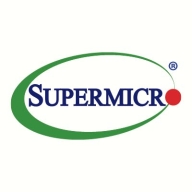

Supermicro SuperBlade and Cisco UCS E-Series Servers compete in the realm of high-density computing solutions. Supermicro SuperBlade excels with superior energy efficiency and flexibility, while Cisco UCS E-Series Servers lead in integration capabilities for enterprise environments.
Features: Supermicro SuperBlade includes high-density configurations, energy-efficient design, and flexible modular components. Cisco UCS E-Series Servers stand out for their seamless integration with existing infrastructures, robust virtualization support, and reliable performance.
Room for Improvement: Supermicro SuperBlade could enhance its integration features and provide more streamlined management interfaces for complex deployments. It could also improve its real-time monitoring capabilities. Cisco UCS E-Series Servers would benefit from enhancing hardware reliability, particularly regarding thermal paste issues. They could also improve cost-effectiveness in initial investments and address minor controller reliability concerns.
Ease of Deployment and Customer Service: Supermicro SuperBlade allows straightforward deployment with substantial support documentation and emphasizes flexible configurations. Cisco UCS E-Series Servers offer a streamlined, centrally managed deployment model with a comprehensive support network, aiming to simplify complex network environments.
Pricing and ROI: Supermicro SuperBlade often presents lower setup costs, achieving high ROI due to energy efficiency. Cisco UCS E-Series Servers may have higher upfront costs but promise long-term value through integration and reduced maintenance. While Supermicro is seen as more cost-effective initially, Cisco is valued for long-term benefits, despite a higher initial outlay.


Cisco UCS E-Series Servers are next-generation, power-optimized, x86, Intel Xeon 64-bit blade servers designed to be deployed in Cisco Integrated Services Routers Generation 2 (ISR G2) and the Cisco 4451-X ISR. These price-to-performance-optimized single-socket blade servers balance simplicity, performance, reliability, and power efficiency. They are well suited for applications and infrastructure services typically deployed in small offices and branch offices.
Supermicro SuperBlade delivers innovative computing performance and efficiency, perfect for data-intensive tasks. With its modular design, it optimizes space and power, providing a flexible and scalable infrastructure for demanding business workloads.
Supermicro SuperBlade is specifically engineered for modern data centers needing high-density computing. It offers a compact, modular architecture that simplifies system management and enhances agility. It integrates seamlessly with cloud and virtualization technologies, supporting diverse applications and workloads. Its design focuses on reducing operational costs while achieving peak performance. Users appreciate its balance of power efficiency and high computing capacity.
What are the key features of Supermicro SuperBlade?Supermicro SuperBlade is widely implemented in sectors such as finance, healthcare, and research where high computational power and storage are critical. In finance, it's used for real-time analytics and transactions. Healthcare facilities use it for patient data analysis and complex simulations, while research institutions leverage SuperBlade for simulations and data-intensive research tasks. Its adaptability allows enterprises to efficiently meet technical requirements unique to each industry.
We monitor all Blade Servers reviews to prevent fraudulent reviews and keep review quality high. We do not post reviews by company employees or direct competitors. We validate each review for authenticity via cross-reference with LinkedIn, and personal follow-up with the reviewer when necessary.